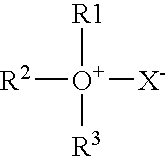Method of making and structuring a photoresist
a photoresist and structure technology, applied in the field of making a novel photoresist, can solve the problems of inability to produce the vertical profile edges requisite for uv-depth lithography, low resolution, unsuitable for precision component molding, etc., and achieve low edge roughness, high edge steepness, and great dimensional stability
- Summary
- Abstract
- Description
- Claims
- Application Information
AI Technical Summary
Benefits of technology
Problems solved by technology
Method used
Image
Examples
example 1
Synthesis of poly-(tert.BuMA / MAA / St)
[0035] 6.785 g of tert.-BuMA, 5.45 g of MAA, 4.94 g of St and 1.04 g of AIBN are dissolved in 170 g of acetone in a three necked flask provided with a stirrer motor, a reflux cooler and an inert gas feed. After stirring for 20 hours under reflux in an inert gas atmosphere (nitrogen), the polymer is obtained by precipitating the clear, colorless reaction solution of higher viscosity in water, followed by syphoning off and drying. The polymer is purified by reprecipitation in an acetonic solution in water, syphoned off and dried at 70° C. in a vacuum.
[0036] Yield: 12.0 g (70.1%) of white powder; Mw: 8,550 g / mol; Tg: 101° C.; Td: 246° C.; Fp: 155-158° C.
example 2
Synthesis of poly-(tert.-BuA / MAA / MMA / St)
[0037] The protocol of the synthesis is analogous to that of Example 1, using the following monomers and proportions in the monomer mixture: Using 15 g of tert.-BuA, 6.72 g of MAA, 7.8 g of MMA, 12.18 h of St and 2.4 g of AIBN in 315 g of acetone, 22.8 g (yield 54.7%) of a white powder are obtained after a reaction time of 26 h.
[0038] Mw: 9, 100 g / mol; Tg: 101° C.; Td: 252° C.; Fp: 126-129° C.
example 3
Synthesis of poly-(tert.-BuA / MAA / BuMA / St)
[0039] The protocol of the synthesis is analogous to that of Example 1 using the following monomers and proportions in the monomer mixture: Using 15 g of tert.-BuA, 6.72 g of MAA, 11.1 g of BuMA, 12.18 g of St and 2.40 g of AIBN in 315 g of acetone yielded 28.7 g (Yield 63.8%) of a white powder after a reaction time of 26 h.
[0040] Mw: 10,500 g / mol; Tg: 107° C.; Td: 250° C.; Fp: 97-101° C.
PUM
| Property | Measurement | Unit |
|---|---|---|
| wavelength range | aaaaa | aaaaa |
| temperature | aaaaa | aaaaa |
| thickness | aaaaa | aaaaa |
Abstract
Description
Claims
Application Information
 Login to View More
Login to View More - R&D
- Intellectual Property
- Life Sciences
- Materials
- Tech Scout
- Unparalleled Data Quality
- Higher Quality Content
- 60% Fewer Hallucinations
Browse by: Latest US Patents, China's latest patents, Technical Efficacy Thesaurus, Application Domain, Technology Topic, Popular Technical Reports.
© 2025 PatSnap. All rights reserved.Legal|Privacy policy|Modern Slavery Act Transparency Statement|Sitemap|About US| Contact US: help@patsnap.com

